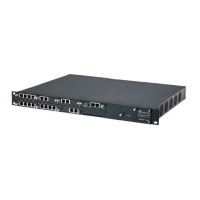Installation & Operation Manual 772 Document # LTRT-92224
Mediant 8000
43.16.2 Media Anchoring with Transcoding
The device performs transcoding when there are no common coders between the two
user agents (i.e., the SDP answer from one user agent doesn't include any coder
included in the offer previously sent by the other user agent). For transcoding, the
device can be configured to add media capabilities to user agents pertaining to a
specific IP Group, and then perform transcoding in cases where the selected coder in
the answer SDP is not one that appears in the original offer. The capabilities that can
be added are one or more of the device's supported coders and are configured by
using the parameter "SBC Extension Coders Group ID" (points to a coders list) in the
IP Profile table (which is assigned to the IP Group). Therefore, to allow user agents of
different IP Groups to communicate with each other (regardless of their capabilities),
an extended coders table with at least one coder that is supported by each IP Groups'
user agents needs to be assigned to each IP Group. Therefore, each offer destined to
specific IP Groups includes this coder.
In the scenario depicted in the figure below, the IP phone on the LAN side initiates a
call to the IP phone in the WAN. The initial SDP offer (from the LAN leg) includes
codec G.711 as its supported codec. Since this is sent to a Destination IP Group that
is configured with an extended coder list, on the WAN leg, the device adds another
supported codec G.729 to the SDP, which is now offered to the WAN IP phone. The
WAN IP phone chooses the extended codec (G.729) in its SDP answer to the device's
WAN leg. Since this codec was not included in the original incoming offer, the device
performs transcoding (between G.729 and G.711) between its two legs, allowing the
streaming of media to occur.
Figure
43-10: Example of SIP call with Media Anchoring with Transcoding

